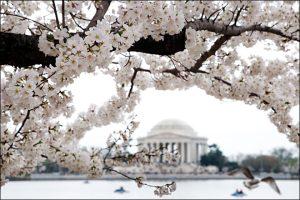In a speech delivered to Congress on April 11, Japanese Prime Minister Fumio Kishida announced that Japan will donate 250 cherry blossom trees to Washington, D.C., to celebrate the 250th anniversary of American independence.
The gesture follows a statement from the National Park Service that the city will implement a three-year project to rehabilitate the seawalls that currently border the Tidal Basin, a man-made reservoir between the Potomac River and the Washington Channel. The existing seawalls have been deemed no longer structurally sound due to rising sea levels and drainage issues in the area.
Kishida said that Japan would be giving the United States a new installment of cherry blossom trees to celebrate the anniversary of America’s independence.
“I know that the National Park Service is undertaking a rehabilitation project in the Tidal basin,” Kishida said in his remarks before Congress. “As a gesture of friendship, Japan will provide 250 cherry trees that will be planted there, in anticipation of the 250th anniversary of your independence.”
The restoration project, supported by the Great American Outdoors Act Legacy Restoration Fund to protect landmarks that line the Potomac River, requires the removal of around 200 of the Japanese cherry blossom trees that currently surround the National Mall.
According to a March 12 statement from the National Park Service, the project will begin in summer 2024 for a $113 million restoration project.
“This critical investment will ensure the park is able to protect some of the nation’s most iconic memorials and the Japanese flowering cherry trees from the immediate threats of failing infrastructure and rising sea levels for the next 100 years,” the statement said.
Adam Liff, a professor of modern Japanese studies at the Georgetown University Walsh School of Foreign Service, said the gift — which comes on the historic anniversary of the signing of the Declaration of Independence — demonstrates diplomacy in action.
“The Japanese cherry trees and the annual festival have become not only widely-recognized symbols of U.S.-Japan friendship, but also of Washington, D.C., itself — attracting people from all over America each year,” Liff wrote to The Hoya. “What a remarkable legacy for the gift — to become the primary natural symbol of the nation’s capital — as well as a great example of the importance of public and cultural diplomacy.”

The practice of Japan gifting cherry trees to Washington, D.C., began in 1912 as a gesture of friendship between the two nations. The initial gift consisted of 3,020 trees of various varieties that were planted along the Tidal Basin.
Liff added that the United States previously reciprocated this diplomatic relationship by restoring the population of trees in Japan following World War II devastation.
“Though it is common knowledge that Japan gave hundreds of cherry trees to America a century ago, less widely appreciated is that after the devastation of the war the U.S. government assisted in restoring the parent grove back in Japan by sharing budwood from its D.C.-based descendants,” Liff said.
“So the trees are both a figurative and literal example of the renewal of U.S.-Japan friendship after the war, and of bilateral exchange,” he added.
Manato Matsuoka (MSB ’26) is the social chair of Japan Network (J-NET) at Georgetown, a Japanese language and culture club. He said the gift demonstrates a renewed connection between Japan and the United States, adding that the club hopes to similarly share Japanese culture through a series of cherry blossom-related events.
“Usually around the cherry blossom festival in Japan there are a lot of picnics and festivals and stands. We kind of wanted to replicate that here at Georgetown,” Manato said.
The club will be hosting Sakura Matsuri, a cherry blossom festival, April 21 to mirror festivals that happen across Japan to celebrate the cherry blossoms each year.
“Cherry blossoms are very symbolic of Japan and they are the Japanese tree. For Japan to put these trees in America is a symbolic gesture of the ties that America and Japan have together,” Manato told The Hoya.
Manato added that a vibrant, strong relationship between Japan and the United States — expressed through cultural institutions like D.C.’s cherry blossoms — is a rare constant in a hectic world.
“Even though what is going on in this world is getting crazier and there are a lot of things going on. Japan and America still have great ties together. We are still something that wouldn’t break apart easily,” Manato said.









